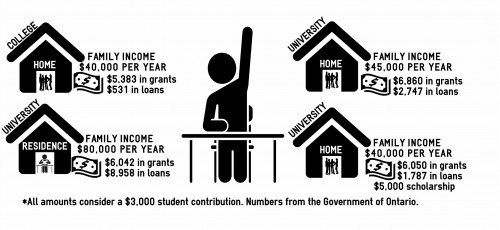Ontario’s 2016 budget plan has pledged “free tuition” for students from low-income families making $50,000 or less per year, starting in the 2017-18 school year.
The Ontario government will create a new grant system titled the “Ontario Student Grant” (OSG), which will cover the cost of tuition for some students, according to a Ministry of Finance news release.
The province projects 150,000 students will be eligible to have their tuition costs covered by the OSG, and an additional 170,000 students will pay less for education than they would under the current system.
Under the OSAP system, certain grants were limited to students who moved to post-secondary education from high school within four years of graduating.
Tanya Blazina, media relations at the Ministry of Training, Colleges, and Universities, said eligibility for the new OSG grant will no longer be associated with the number of years a student has been out of high school. This will benefit students of all ages, she said.
Mature and married students will receive more support under the new system. The government report gave an example of a married student who would receive nearly $3,000 more per year of support than they would under the current system.
First-year global and international studies student Kaitlyn Gee said she is extremely happy about the government’s announcement.
“I fall under the $50,000 category. So it means free tuition for me, which is awesome,” she said. “I’ll still be in debt for other things, but at least [the OSG] makes it not such a large burden, which is nice.”
Lindsee Perkins, the vice-president of human resources and administration for the Ontario Undergraduate Student Alliance (OUSA), said these changes are an amazing step forward.
“We are extremely happy with the way that the provincial government has laid out these new suggestions for student financial assistance. It’s a really big improvement and a lot of students will really benefit from it,” Perkins said.
Many of the changes to post-secondary funding in the budget plan were taken directly from suggestions made in OUSA’s budget submission to the government, she explained. In this submission, OUSA directly advocated for non-repayable grants for lower income students.
“I think OUSA was actually the main driver in a lot of these changes. The budget actually suggested a lot of the recommendations that came right from our submission to the government,” Perkins said.
However, the new forms of student aid outlined in the budget plan have also received criticism.
Dane Rowlands, director of the Norman Paterson School of International Affairs at Carleton University, expressed some concern towards the government’s proposal.
Rowlands said students who previously couldn’t afford post-secondary education will have better access to university and college, which could cause an increase in students.
“In the absence of additional resources flowing into the universities, it’s not easy to see how more students are going to be accommodated,” Rowlands explained.
“In the sense that you’re removing a barrier for people to attend universities—which is an equity issue—then I think it’s probably not a bad idea,” he added.
Second-year global politics student Trevor Schonewille said he isn’t impacted directly by the OSG, but he thinks it’s great students from low-income families will have the opportunity to attend university.
“The only problem I can see coming out of it is if something’s given for free, sometimes people don’t appreciate how it’s given,” he said. “Some people might [take] advantage of this program and not try at university as much as they might if they were spending a ton of money on it.”






